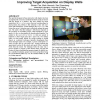Free Online Productivity Tools
i2Speak
i2Symbol
i2OCR
iTex2Img
iWeb2Print
iWeb2Shot
i2Type
iPdf2Split
iPdf2Merge
i2Bopomofo
i2Arabic
i2Style
i2Image
i2PDF
iLatex2Rtf
Sci2ools
ICMI
2007
Springer
2007
Springer
Speech-filtered bubble ray: improving target acquisition on display walls
The rapid development of large interactive wall displays has been accompanied by research on methods that allow people to interact with the display at a distance. The basic method for target acquisition is by ray casting a cursor from one’s pointing finger or hand position; the problem is that selection is slow and errorprone with small targets. A better method is the bubble cursor that resizes the cursor’s activation area to effectively enlarge the target size. The catch is that this technique’s effectiveness depends on the proximity of surrounding targets: while beneficial in sparse spaces, it is less so when targets are densely packed together. Our method is the speech-filtered bubble ray that uses speech to transform a dense target space into a sparse one. Our strategy builds on what people already do: people pointing to distant objects in a physical workspace typically disambiguate their choice through speech. For example, a person could point to a stack of books and say â€...
| Added | 08 Jun 2010 |
| Updated | 08 Jun 2010 |
| Type | Conference |
| Year | 2007 |
| Where | ICMI |
| Authors | Edward Tse, Mark S. Hancock, Saul Greenberg |
Comments (0)

